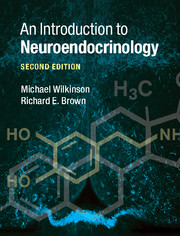Book contents
- Frontmatter
- Dedication
- Contents
- Preface to the second edition
- Acknowledgements
- List of abbreviations
- 1 Classification of chemical messengers
- 2 The endocrine glands and their hormones
- 3 The pituitary gland and its hormones
- 4 The hypothalamic hormones
- 5 Neurotransmitters
- 6 Neurotransmitter and neuropeptide control of hypothalamic, pituitary and other hormones
- 7 Regulation of hormone synthesis, storage, release, transport and deactivation
- 8 Regulation of hormone levels in the bloodstream
- 9 Steroid and thyroid hormone receptors
- 10 Receptors for peptide hormones, neuropeptides and neurotransmitters
- 11 Neuropeptides I: classification, synthesis and co-localization with classical neurotransmitters
- 12 Neuropeptides II: function
- 13 Cytokines and the interaction between the neuroendocrine and immune systems
- 14 Methods for the study of behavioral neuroendocrinology
- 15 An overview of behavioral neuroendocrinology: present, past and future
- Index
- References
12 - Neuropeptides II: function
Published online by Cambridge University Press: 05 June 2015
- Frontmatter
- Dedication
- Contents
- Preface to the second edition
- Acknowledgements
- List of abbreviations
- 1 Classification of chemical messengers
- 2 The endocrine glands and their hormones
- 3 The pituitary gland and its hormones
- 4 The hypothalamic hormones
- 5 Neurotransmitters
- 6 Neurotransmitter and neuropeptide control of hypothalamic, pituitary and other hormones
- 7 Regulation of hormone synthesis, storage, release, transport and deactivation
- 8 Regulation of hormone levels in the bloodstream
- 9 Steroid and thyroid hormone receptors
- 10 Receptors for peptide hormones, neuropeptides and neurotransmitters
- 11 Neuropeptides I: classification, synthesis and co-localization with classical neurotransmitters
- 12 Neuropeptides II: function
- 13 Cytokines and the interaction between the neuroendocrine and immune systems
- 14 Methods for the study of behavioral neuroendocrinology
- 15 An overview of behavioral neuroendocrinology: present, past and future
- Index
- References
Summary
As noted in Chapter 11, the human genome contains about 90 genes that encode neuropeptide precursors (pre-propeptides). The biologically active neuropeptide products of the prepropeptides number at least 100, and there are likely to be many more waiting to be discovered. Neuropeptides are synthesized in a wide variety of neurons in many brain regions and more often than not are co-localized and co-released with classical neurotransmitters. Should neuropeptides therefore be categorized as neurotransmitters? An alternative description is that of neuromodulator, since in many instances they modify the neural effects of classical neurotransmitters. A good example of this is shown in Figure 11.2, where co-release of a neuropeptide totally modifies the influence of the co-localized neurotransmitter on a postsynaptic neuron. This chapter will illustrate the neurotransmitter and neuromodulator actions of neuropeptides on the neuroendocrine system, the autonomic nervous system (ANS) and the central nervous system. First, however, we will explore whether neuropeptides are best described as neurotransmitters or neuromodulators, or both.
Neurotransmitter and neuromodulator actions of neuropeptides: a dichotomy or a continuum?
An initial useful exercise is to establish criteria by which a neuromodulator could be defined. Recall that in Chapter 5 several criteria were established to ascertain whether a neurochemical might be considered to be a neurotransmitter (Table 5.1). In brief, these are: (1) synthesized in neurons; (2) present in the presynaptic nerve terminals, usually contained in vesicles, and released into the synapse in amounts sufficient to stimulate the postsynaptic cell; (3) whether endogenously released or applied exogenously, a neurotransmitter should have the same effect on the postsynaptic cell (i.e. it activates the same ion channels or second messenger pathways); (4) receptors specific to the neurotransmitter should be present postsynaptically; (5) receptor antagonists should prevent #3; and (6) a specific deactivating mechanism should exist in the synapse.
Strictly speaking, all of these criteria apply equally well to neuropeptides, with some qualifications. For example, classical neurotransmitters are made by enzymatic transformation (criterion #1) of a single amino acid transported into the neuron from the circulation, whereas neuropeptides are produced via changes in gene expression.
- Type
- Chapter
- Information
- An Introduction to Neuroendocrinology , pp. 286 - 350Publisher: Cambridge University PressPrint publication year: 2015



